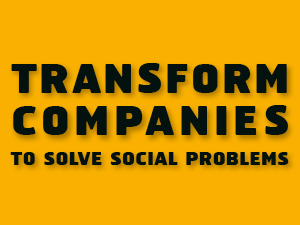
Shana Cohen
Shana Cohen is Deputy Director, Woolf Institute, Stone Ashdown Director, Senior Research Associate, St Edmund's College, University of Cambridge, Cambridge Urban/Rural Sociology, Qualitative Social Research, Social Policy ...
Voir l'auteur ...Transform companies to solve social problems
Introduction
In a conversation about 15 years ago with a senior policy advisor in Morocco, he mentioned an effort by local administrators to convince a group of entrepreneurs who had set up informal stalls in an abandoned building to apply for business permits. They would be legalized but also have to pay taxes, which did not interest them. The entrepreneurs ended up rejecting the offer, preferring to coordinate amongst themselves rather than with the government about where, how, and when to sell their goods. In other words, they wanted to retain their independence and they trusted each other more than the local authority. Many years later, responding to the Arab Spring, the 2013World Development Report stated that employment “can increase the extent to which people perceive that they have a stake in society. This perception can be especially critical when risks of social unrest from youth unemployment and conflict are high.” (36-37) The report warns against programs that “can undermine social cohesion if they have weak governance or divisive targeting” and recommends programs such as public works that “can facilitate community participation and engagement between citizens and local authorities.” (Ibid).
This paper asks how to reconcile the demand for jobs, the need for these jobs to promote social cohesion and reduce political alienation, and the distance between the state and the owners of small and micro enterprises creating the kinds of jobs that foster a sense of social solidarity. In referring to small and micro enterprises, the paper relies upon the European Union definition of a business with less than 50 employees.2 A micro enterprise has less than 10 employees. Economic growth rates and national social, health, and education programmes (e.g. INDH or the various educational reform policies) alone cannot combat the combination of economic and social problems, increasingly coupled with the effects of climate change. Drawing on research conducted in Morocco and the UK on non-profit organizations and services, this paper suggests that policies must focus as well on developing small and micro enterprises that function as a means of delivering solutions to joblessness, local and national problems, and the need for social belonging.
In the past, the public administration filled the combined economic and social role, providing opportunities for social mobility and economic security while promoting nationalism and the notion of citizenship within the nation-state.(Cohen 2004) With shrinking resources and pervasive political disaffection, in Morocco and elsewhere, the state no longer can bridge individual material circumstances with collective identity. In recent policy, the state has focused on improving the quality of training and higher education to find jobs in the private sector to make this link. The Moroccan Program to Support Appropriate Training for Employment (PAAFE) includes social objectives in its mission, for example, “the deepening of national identity” and “the establishment of a new social contract” (2013: 11). I suggest thatnew forms of small and micro enterprises can fill the function of connecting the experience of social belonging, namely citizenship, with employment and social mobility because of their ability to generate jobs (Akugri et al 2015, ILO 2015),3 respond quickly to changing circumstances and issues, and rootedness in the local environment.To achieve this, the state must regulate working conditions, which can be unacceptable,4 especially in the informal sector (ILO 2015),but also institute measures of impact and establish a system of rewards based on contribution to the local social, economic, and physical environment.This could come from state subsidies and consumer interest but also, importantly, access to reliable networks, public relations, and political influence. In other words, these enterprises will not be isolated and potentially vulnerable but rather supported by their social role. To develop these assets, however, small enterprises and policymakers may have to learn from effective non-profit management practices and evidence of how small and micro businesses can have an impact on social life.
Learning from NGOs
The 2013 World Development Report on jobs cites the marketplace and business networks, namely neutral sites focused on exchange and mutual benefit regardless of ethnic or religious origin, as zones of peace building:
- In Sadakhlo market in Georgia, next to the borders with Armenia and
- Azerbaijan, one does not hear the virulent expressions of mutual hatred
- one can hear a few miles away across the border. ‘They fight, we don’t,’
- says Mukhta, a trader from Azerbaijan, while putting his arm round his
- Armenian colleague Ashot. (136)
In another example, the report cites networks of traders in Guinea, where “members of the Malinke ethnic group are wholesalers in the groundnut market chain, while the primary producers of groundnuts tend to be Guerse.” (Ibid) The two ethnic groups are willing to conduct business together because of their mutual economic benefit, which, in turn, is helping to diminish existing tensions.
The question, then, is how to expand upon this observation to create a sustained social role for small and micro enterprises? This role differs from much of the research focus on SMEs, which analyzes their social impact (Smeaton et al 2011), for example, how micro enterprises contribute to women’s status because of their income. It also differs from the function of social enterprises, which are businesses that have a social mission. According to the national membership body for social enterprises in the UK, Social Enterprise UK, in addition to a social or environmental purpose, social enterprises must act independently of the state, generate majority of their income through engaging trade, and reinvest the majority of their income in the business. They should also be models of transparency and set in place regulations to avoid a sale where the mission will be jeopardized.5 Examples of social enterprises in the UK include a magazine called the Big Issue, which is sold to support the homeless, and restaurants in prisons designed to provide skills to inmates in preparation for release.
In contrast, determining how small and micro enterprises can possess a social role, particularly in relation to the complex relationship between citizenship and individual life opportunity, necessitates rethinking the internal management and social embeddedness (Evans 1995) of the business. My research over 15 years with dozens of grassroots organizations and NGOs in England and Morocco can offer potential insight into how to develop the social role of enterprises. In addition to conducting research on the politics and organization of social action, I have led on numerous evaluations and training courses on project design, management, and evaluation. I suggest that non-profit organizations can contribute to considering new forms and aims for small and micro enterprises because1) when they mobilize diverse sources of funding and in-kind resources to grow or just to survive, they build social networks, encourage employee agency and independent thinking, and learn to develop creative solutions;2) their evolution often depends upon high staff morale, which is based both on fair pay and a diverse workforce (including former service beneficiaries), as any lack of collegiality and cooperation can result in high, costly turnover and overreliance on the director for stability;3) they must innovate to adapt to the changing nature of social problems, the local and national contexts, and politics or they will not grow, or even last; and 4) they must eventually collaborate with other organizations, whether through networks or funding, if they want to expand their influence and authority.
Looking at internal management, utilizing scarce resources innovatively allows NGOs to weather shifts in policy and to encourage staff to think creatively and independently to maintain or expand services, generating a sense of agency amongst staff and capacity to overcome obstacles. For instance, a consultant, a man with decades of experience working for NGOs, described the contradictions of government literacy policy in the early 00s: “The state wants writing,reading, and math, in that order, and the women want math, reading, and writing. For women in Berber areas, learning to write Arabic is like learning a foreign language.” However, he added, the flaws of the policy did not stop organizations from being resourceful with the funding and structure provided to offer the right kind of course to meet needs: “What organizations do is to use the literacy program as a module to create new activities. They work on the literacy program for a year, get to know the social environment better and then do something else.”
The necessity of encouraging and rewarding agency can also facilitate retaining staff even when the organization is facing funding and other challenges. A young man volunteering for a well-established organization in Sale once told me that he earned a living working for an agency distributing media and volunteered for the organization because “I have time.” He explained, “I have been with [the organization] for many years so I have contributed to its evolution. When we received the funding [from an international organization], we decided Hicham [a colleague] would become full-time. He didn’t have work and was also very engaged. I will take a job in the future.” Likewise, ensuring representation in the staff of the different ethnic and socio-economic groups in the local population can lead to sustained support for the organization. For example, a local trade association in a highly diverse area of Londonincludes businesses from a number of migrant communities and, in turn, acts to defend the interests of small family-owned enterprises against national and international chains, creating a self-reinforcing dynamic whereby members interpret diversity as a means for the association itself to survive and to protect their own livelihoods. The director of a small project to support mothers and children from another diverse area of London included representatives from different ethnic communities on the management board in order to encourage participation and investment in the project amongst these communities.
Non-profit organizations also have to adapt to changes in the social problem they address and work through networks if they intend to grow. All non-profits aim to put themselves out of business, in the sense of eradicating the problem. In the event this is impossible, which unfortunately it usually is, then they need to alter their work to confront new aspects or dimensions of social need. For instance, an organization in a small city in England originally aimed to provide a meeting place for low-income mothers and their children. The complexity of needs these mothers demonstrated because of cuts to welfare payments made the directors increase the range of their services, with their space now becoming a hub for different kinds of government and private support services from all over the city. They were then able to access diverse funding sources and gain greater visibility, especially within the local government, which provides the space for a low rent and includes them in relevant policy meetings.
What is the relevance of these lessons on how NGOs survive for a new policy strategy regarding small and micro enterprises? If political objectives, whether at a national or international level, become to make these enterprises a site for connecting individual life chances and an experience of social solidarity and belonging and to engage them more in the practical work of addressing local social problems, then there is arguably a clear basis for policymaking. Encouraging enterprises to hire staff from diverse backgrounds and provide transparent opportunities for mobility within the firm represent standard recommendations, though they are often not implemented.Beyond obvious internal management guidelines, policy can provide incentives for enterprises to become more embedded in networks with NGOs and public actors, exchange and utilize similar resources, and share knowledgeand devise collective strategies to respond to complex local issues. They thus become part of a combined effort to instigate social change, and staff can link their own advancement and agency to progress among the wider population. For example, a teacher at state secondary school in Rabat once told me that parent-teacher associations are critical for schools suffering a shortage of resources because they can mobilize to replace these resources. Small and micro enterprises involved in education, technology, communication, or related areas, can contribute to this effort by being contracted to work with schools, NGOs involved in education, and PTAs in growing the associations and their capacity to make positive changes in their children’s education. The contract would not simply be for a service, however; it would include hiring parents to work in this area, sharing office space within a school, being involved in the improvement of school activities, and training teachers to cooperate better with parents. In other words, they would be hired to help form effective relationships without which the original service could not succeed and to contribute to an organized, collective effort.
Conclusion
Academic research generally focuses on defining types of organizations and differentiating between the private, public, and third sectors. Theorists of non-profit organizations have used the production of social good as a way of identifying these organizations. Morris writes, “The third sector fosters social capital that in turn promotes economic growth and contributes to the healthy operation of democratic societies.” (2000, 4) Non-profits differ from the state, which intervenes to supply public goods that markets otherwise would not supply, like clean air, because they depend on collective action and cannot be sold. (Salamon and Toepler 2015) For scholars of non-profit organizations like Lester Salamon, they are service providers that are able to respond quickly and more intensively than state institutions and agencies. (2015: 2162) Furthermore, as he and Toepler write, “alone among societal institutions, they are capable of mobilizing individual initiative for the public good.” This characteristic “differentiates them from market institutions, which mobilize individual initiative but for individual gain, and from governmental institutions, which pursue the public good but do so through collective action.” (2163)
However, is the concern for defining existing organizational forms obscuring the need to rethink and revise these forms altogether in order to address global, national, and local problems? For example, there are tensions between different religious and ethnic groups in most, if not all, of the world, leading to violence and undermining democracy and equality. In urban areas in particular, tensions may express themselves in riots, gang and other kinds of violence, and police, labor market, and state discrimination. Policymakers could ask which platform is best suited to offer goods that lessen tensions, but, on the other hand, would a better question be how to develop a suitable platform that reflects the causes of tensions?.
Réferences
· African Development Bank. 2013. Programme d’Appui à l’Adéquation Formation-Emploi (PAAFE)
· Akugri, Musah S. 2015. “The Contributions of Small and Medium Scale Enterprises toEconomic Growth: A Cross-Sectional study of Zebilla in theBawku West District of Northern Ghana,” The European Journal of Business Management, Vol. 7, No. 9 pp. 262-275.
· Cohen, Shana. 2004. Searching for a Different Future. Durham, NC: Duke University Press.
· Evans, Peter. 1995. Embedded Autonomy. Princeton, NJ: Princeton University Press.
· ILO. 2015. Small and medium-sized enterprises and decent and productive employment creation. International Labour Conference, 104th session.
· Salamon, Lester and Toepler, Stefan. 2015. “Government-Nonprofit Cooperation: Anomaly or Necessity?” VoluntasVol. 26, Issue 6, pp. 2155 - 2177.
· Smeaton, Deborah. 2011. The Impact of BIG Funding on Community Enterprise Overseas, The Policy Institute of SOAS.
· World Bank. 2012. World Development Report 2013: Jobs. Washington, DC: The World Bank.
Notes
- This article was made possible by NPRP grant 75856020 from the Qatar National Research Fund (a member of Qatar Foundation). The statements made herein are solely the responsibility of the author.
- http://ec.europa.eu/growth/smes/business-friendly-environment/sme-definition_en
- In the EU, 99% of all businesses are small and medium-sized. (Ibid)
- The recent UK ruling against Uber, which is not a small company but has relied upon declaring its drivers ‘self-employed’, is a corrective measure in favor of improving labor conditions. https://www.theguardian.com/technology/2016/oct/28/uber-ruling-is-a-massive-boost-for-a-fairer-jobs-market
- http://www.socialenterprise.org.uk/uploads/files/2012/04/what_makes_a_social_enterprise_a_social_enterprise_april_2012.pdf


